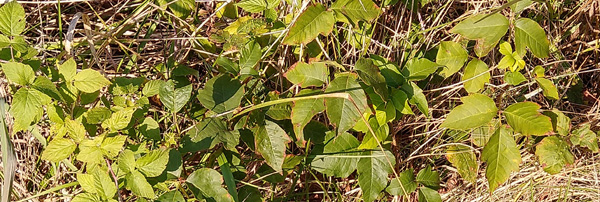If we are to make real headway clearing the poison ivy from our favorite people-activity areas at the church, we are in need of a few more individuals who will partner with us from time to time on this important task. Some of our grounds team members have the know-how and experience to do safe, surgical removal of poison ivy. Working in a twosome with proper clothing and careful methods can be safe for the workers and can effectively eradicate the plants. If you can help, please email the Grounds Team.

with similar looking raspberry leaves at left
A few “why’s” and “how’s” of poison ivy:
Because we maintain sunny openings for ourselves, rather than allowing natural succession to turn all the church grounds into woods, we humans are, inadvertently, encouragers of poison ivy – it likes sunny edges.
Edges of woods naturally tend toward becoming super productive places. They benefit from the microclimate and soil enhancements of woods on the one side, and from the abundance of energetic sun and air on the other. They can become great walls of lush woody plant growth that protect the woods edge from overexposure while producing an abundance of fruits, nuts, and protective cover for birds, mammals, and others.
But, here’s the thing: Birds benefit from eating the berries of poison ivy, and then they plant the seeds, encased in a packet of bird-poop fertilizer. They plant it right at the productive edges where they are hanging out eating berries and hiding from predators. And that is just where we human mammals like to hang out too, walking into the woods or on the meadow path, picking a plum, or traversing the east stairs. So, if we don’t want ourselves and our children to be exposed to poison ivy, it behooves us to discourage it from growing in these spots. And we do.
